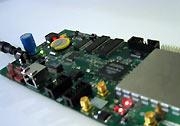New receiver board is Australian first
UNSW researchers have developed the first Australian receiver that can pick up both the L1 and L2C GPS frequencies, as well as the signal from the first prototype Galileo satellite.
UNSW researchers have developed the first Australian receiver that can pick up both the L1 and L2C GPS frequencies, as well as the signal from the first prototype Galileo satellite.

UNSW researchers have developed the first Australian receiver that can pick up both the L1 and L2C GPS frequencies, as well as the signal from the first prototype Galileo satellite.
"We are the first people in Australia to design hardware and software that will pick up the Galileo signal," explains Associate Professor Andrew Dempster, Director of Research in the School of Surveying and Spatial Information Systems.
"In addition to that our board also allows us to pick up both the L1 and L2C GPS signals. Developing technology that picks up all three signals will enable researchers to make satellite navigation more accurate - rather than metre-level accuracy, this will mean centimetre-level accuracy should be available in inexpensive receivers."
The team have now started work on a version of the board that would have two front ends, enabling it to tune in to L1 and L2C at the same time. It will also have a USB port for data logging.
The board, the FPGA design and the on-board software have been made open source and are available on the Internet. Click here for more information.